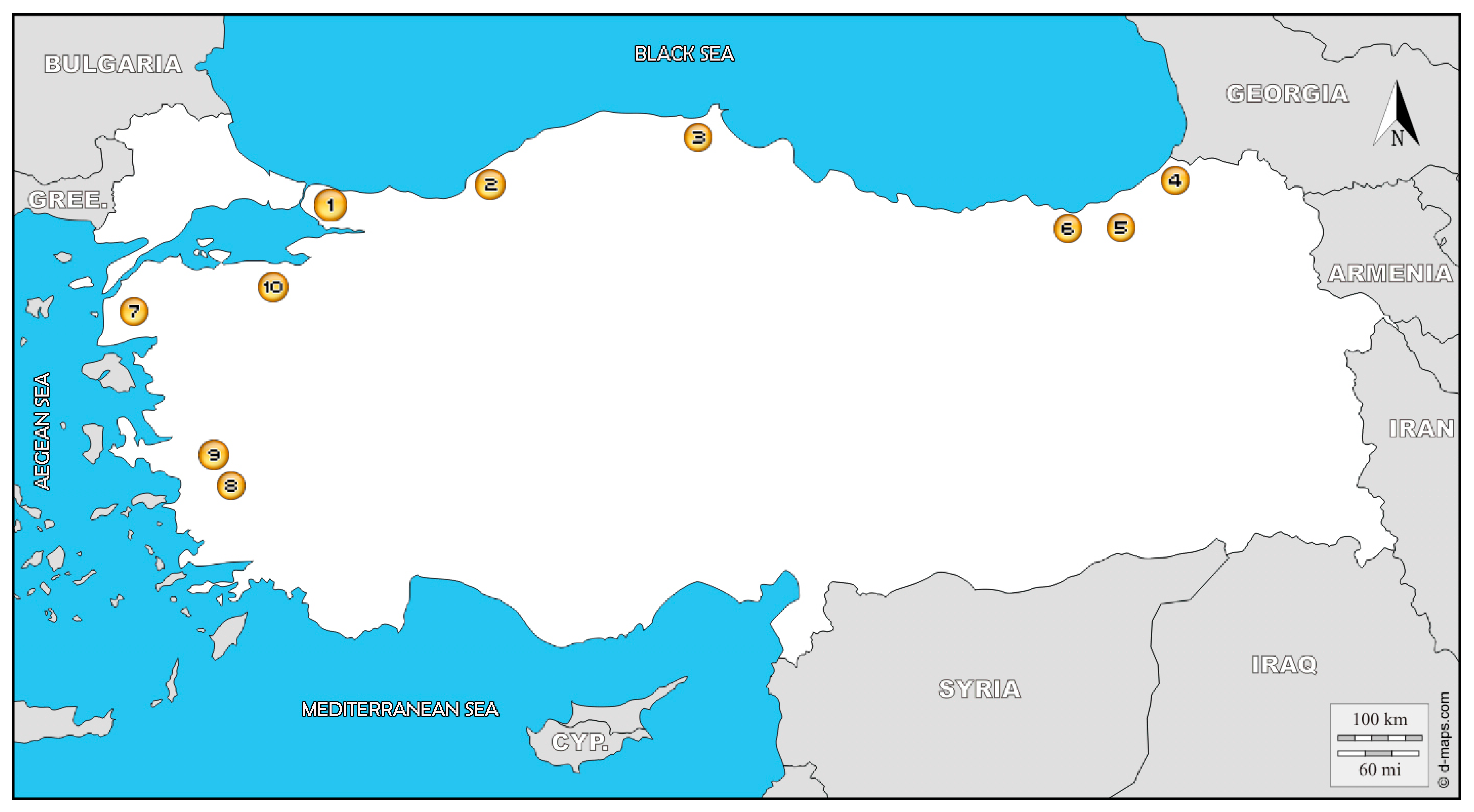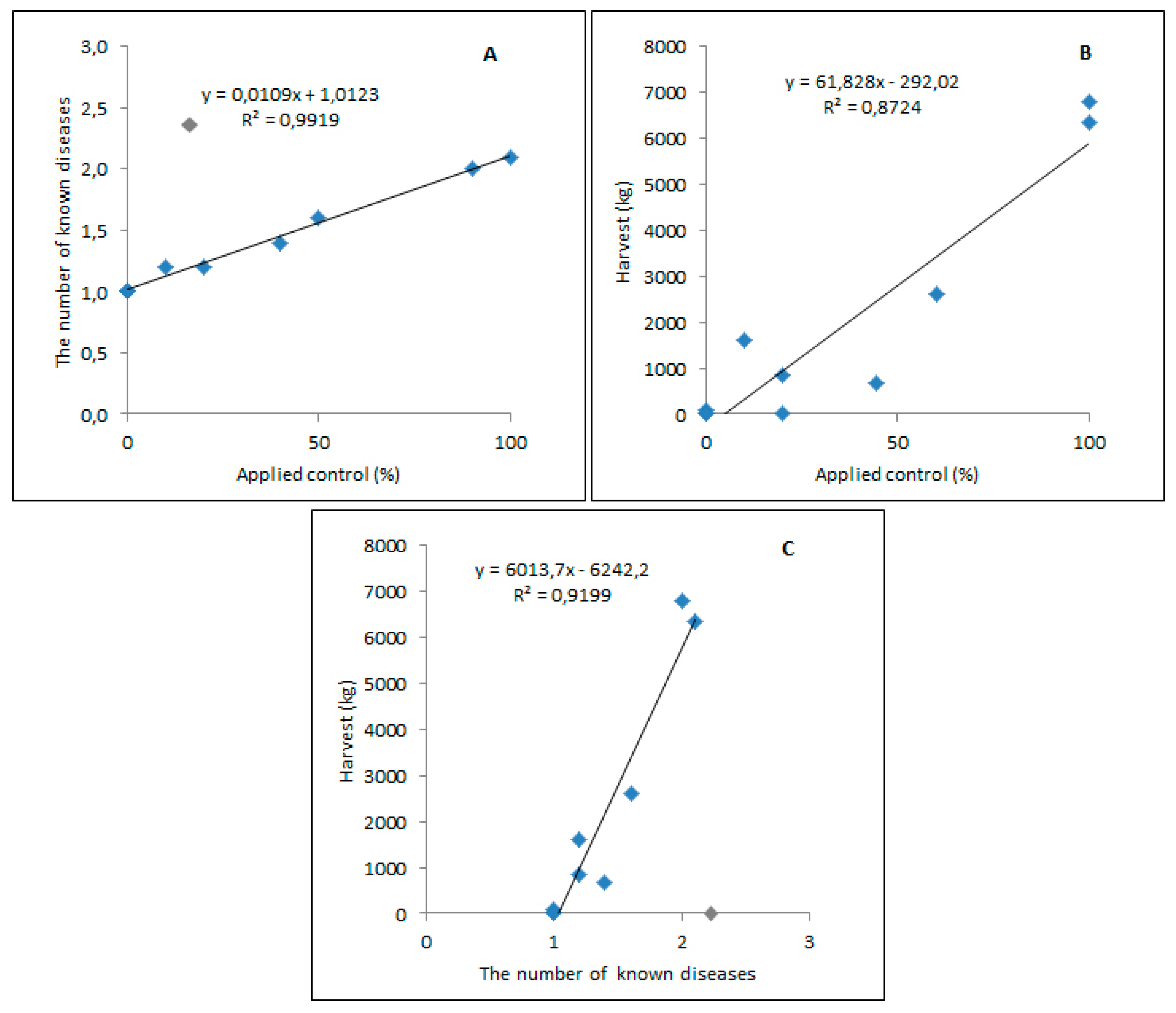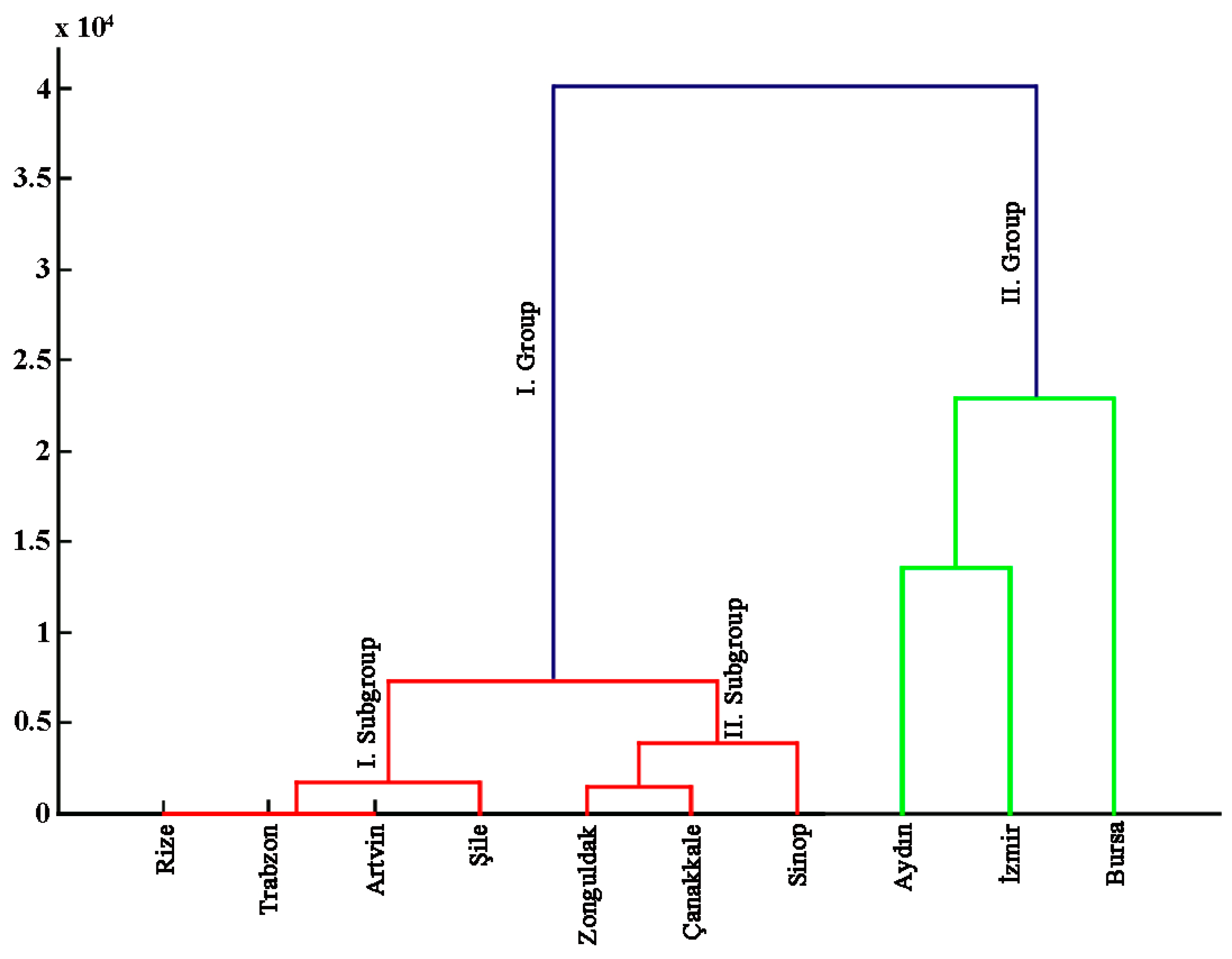Socioeconomic Perspectives on Household Chestnut Fruit Utilization and Chestnut Blight Prevention Efforts in Turkey
Abstract
:1. Introduction
2. Material and Methods
3. Results
3.1. The Results of Interviews with Households
3.2. The Results of Regression Analysis
3.3. The Results of Cluster Analysis
4. Discussion
5. Conclusions
Acknowledgments
Author Contributions
Conflicts of Interest
References
- Xenophon. Anabasis; Wells, E.A., Ed.; Macmillan and Company Limited: London, UK, 1917. [Google Scholar]
- De-Leonardis, W.; De-Santis, C.; Fichera, G.; Fiumara, P.M.R.; Longhitano, N.; Zizza, A. Importance of Castanea sativa Mill. in honeys of central and north-eastern Sicily on the basis of the pollen grain analysis. Ecol. Mediterr. 2000, 26, 169–175. [Google Scholar]
- Yaltırık, F. Dendroloji Ders Kitabı II (Angiospermae); Emek Matbaacılık: İstanbul, Turkey, 1998; pp. 118–122. [Google Scholar]
- Yılmaz, H. Castena Mill. In Türkiye’nin Doğal-Egzotik Ağaç ve Çalıları I; Akkemik, Ü., Yayınları, O.G.M., Eds.; MRK Baskı ve Tanıtım: Ankara, Turkey, 2014; pp. 668–669. [Google Scholar]
- Erdem, R. Türkiye’de Kestane Ölümünün Sebepleri ve Savaş Imkanları; Tarım Bakanlığı Orman Genel Müdürlüğü Yayınları: Ankara, Turkey, 1951. [Google Scholar]
- Akdoğan, S.; Erkam, E. Dikkat Kestane Kanseri Görüldü. Tomurcuk 1968, 1, 4–5. [Google Scholar]
- Doğanlar, M. First reports on the natural enemy fauna of the Chesnut Gall-wasp, Dryocosmus kuriphilus Yasumatsu (Hymenoptera: Cynipidae) in Yalova, Turkey. Türk. Biyo. Müc. Derg. 2014, 5, 67–74. [Google Scholar]
- Akıllı, S. Feasibility of biological control of chestnut blight caused by Cryphonectria parasitica, in Marmara region of Turkey. Afr. J. Agric. Res. 2012, 7, 6068–6072. [Google Scholar]
- Erincik, Ö.; Özdemir, Z.; Durdu, Ö.F.; Döken, M.T.; Açıkgöz, S. Diversity and spatial distribution of vegetative compatibility types and mating types of Cryphonectria parasitica in the Aydın Mountains, Turkey. Eur. J. Plant Pathol. 2011, 129, 555–566. [Google Scholar] [CrossRef]
- FAO (Food and Agriculture Organization). Support to the Turkish Government in Development and Implementation of a Feasibility Study (FS) for Management of Chestnut Blight in Chestnuts and Other Hardwoods. Report on Chestnut Blight and Its Management in Turkey. 2009. Available online: http://www.fao.org/forestry/49410/en/tur/ (accessed on 23 February 2017).
- Pezzi, G.; Lucchi, E.; Maresi, G.; Ferretti, F.; Viaggi, D.; Frascaroli, F. Abandonment or survival? Understanding the future of Castanea sativa stands in function of local attitude (Northern Apennine, Italy). Land Use Policy 2017, 61, 564–574. [Google Scholar] [CrossRef]
- Oliva, J.; Castano, C.; Baulenas, E.; Dominguez, G.; González-Olabarria, J.R.; Oliach, D. The impact of the socioeconomic environment on the implementation of control measures against an invasive forest pathogen. For. Ecol. Manag. 2016, 380, 118–127. [Google Scholar] [CrossRef]
- Wall, J.; Köse, C.; Okan, T.; Köse, N.; Jarvis, D.I. Evidence of Landscape-Level Chestnut Blight Severity Mitigation by Livelihood Practices in Turkey. Biol. Conserv. 2017. under review. [Google Scholar]
- Anagnostakis, S.L. Chestnut Blight: The Classical Problem of an Introduced Pathogen. Mycologia 1987, 79, 23–37. [Google Scholar] [CrossRef]
- Gürer, M.; Turchetti, T.; Biagioni, P.; Maresi, G. Assessment and characterization of Turkish hypovirulent isolates of Cryphonectria parasitica (Murr.) Barr. Phytopathol. Mediterr. 2001, 40, 265–275. [Google Scholar]
- FAO (Food and Agriculture Organization). FAOSTAT. 2017. Available online: http://www.fao.org/faostat/en/#data/QC (accessed on 9 March 2017).
- Akıllı, S.; Katırcıoğlu, Y.Z.; Maden, S. Vegetative compatibility types of Cryphonectria parasitica, causal agent of chestnut blight, in the Black Sea region of Turkey. For. Pathol. 2009, 39, 390–396. [Google Scholar]
- Akıllı, S.; Ulubaş Serçe, Ç.; Katırcıoğlu, Y.Z. Characterization of hypovirulent isolates of the chestnut blight fungus, Cryphonectria parasitica from the Marmara and Black Sea regions of Turkey. Eur. J. Plant Pathol. 2013, 135, 323. [Google Scholar] [CrossRef]
- Tandoğan, A. Türkiye Nüfus Hareketlerinde İstanbul’un Yeri. Available online: tucaum.ankara.edu.tr/wp-content/uploads/sites/280/2015/08/cadata1_12.pdf (accessed on 15 May 2017).
- Yakar, M. Türkiye’de iç göçlerin ilçelere göre mekânsal analizi: 1995–2000 dönemi. Uluslar. İnsan Bilim. Derg. 2012, 9, 741–768. [Google Scholar]
- Zonguldak Chamber of Agriculture. Zonguldak Kestanesi ve Cevizine Yönelik Markalaşma Çalışmaları Projesi. 2014. Available online: http://bakkakutuphane.org/upload/dokumandosya/zonguldak-kestanesi-ve-cevizine-yonelik-markalasma-calismalari-projesi.pdf (accessed on 3 Janaury 2017).
- General Directorate of Forestry. T.C. Orman ve Su İşleri Bakanlığı Ormancılık ve Su Şurası. In Proceedings of the Çalışma Grubu 10: Ormanlardan Faydalanma Şura Çalışma Belgesi, Ankara, Turkey, 21–23 March 2013. [Google Scholar]
- General Directorate of Forestry. Kestane Eylem Planı (2013–2017). 2012. Available online: http://www.ogm.gov.tr/Lists/Haberler/Attachments/457/KESTANE%20EYLEM%20PLANI.pdf (accessed on 12 March 2017).
- Kaya, Z.; Raynal, D.J. Biodiversity and conservation of Turkish forests. Biol. Conserv. 2001, 97, 131–141. [Google Scholar] [CrossRef]
- Köhn, H.-F.; Hubert, L.J. Hierarchical Cluster Analysis. In Wiley StatsRef: Statistics Reference Online; John Wiley & Sons: Hoboken, NJ, USA, 2015; pp. 1–13. [Google Scholar]
- Soylu, A. Chestnut Growing and Its Characteristics; Hasat Yayıncılık: İstanbul, Turkey, 2004; p. 64. (In Turkish) [Google Scholar]
- Ertürk, Ü.; Mert, C.; Soylu, A. Chemical Composition of Fruits of Some Important Chestnut Cultivars. Braz. Arch. Biol. Technol. 2006, 49, 183–188. [Google Scholar] [CrossRef]
- Porsuk, T.; Özyürek, E.; Karahan, A.; Başar, M.; Çetiner, Ş. Research on Socioeconomical Effects of Chestnut (Castanea Sativa Mill.) Fruit Harvesting to Forest Villager in Simav County, Kütahya Province; Technical bulletin No. 295; Central Anatolia Turkish Forestry Research Institute: Ankara, Turkey, 2012. [Google Scholar]
- Karadeniz, V. Chestnut Agriculture in Turkey and Its main Problems. J. Int. Soc. Res. 2013, 6, 279–291. [Google Scholar]
- OEPP/EPPO. Dryocosmus Kuriphilus. Bulletin. 35. pp. 422–424. Available online: https://www.eppo.int/QUARANTINE/data_sheets/insects/DS_Dryocosmus_kuriphilus.pdf (accessed on 22 March 2017).
- Atmış, E.; Günşen, B. Türkiye’de hükümetlerin ormancılık politika ve uygulamaları üzerine eleştirel bir değerlendirme-AKP örneği. Orman ve Av Dergisi. Türk. Orman. Dern. Yayını 2009, 2, 33–42. [Google Scholar]
- Bekiroğlu, S.; Atıcı, E.; Özkul Özer, G.; Yadigar, S.; Uslu, B. The Origins of Coppice Forests and the Socio-Economic Dimension of Conversion of Coppice Forests to High Forests (Istanbul Case). JFFIU 2013, 63, 61–70. (In Turkish) [Google Scholar]
- General Directorate of Forestry. Baltalık Ormanlarının Koruya Dönüştürülmesi Eylem Planı (2006–2015); Çevre Orman Bakanlığı Orman Genel Müdürlüğü: Ankara, Turkey, 2006.
- Aydın Commodity Exchange. 2013 Yılı Kestane Borsası. Available online: http://aydinticaretborsasi.org.tr/yonetim/pdf/16112016153652u.pdf (accessed on 15 March 2017).
- Bitkisel Üretim İstatistikleri. 2017. Available online: https://biruni.tuik.gov.tr/bitkiselapp/bitkisel.zul (accessed on 15 march 2017).
- Okan, T.; Köse, C.; Aksoy, E.B.; Köse, N.; Wall, J.R. Traditional Terms for Sweet Chestnut (Castanea sativa Mill.) and Its Usage in Turkey. Avrasya Terim Derg. 2017, 5, 19–27. [Google Scholar]
- Kayacık, H. Orman ve Park ağaçlarının Özel sistematiği. Cilt II; Kurtulmuş Matbaası: İstanbul, Turkey, 1967. [Google Scholar]
- Bozkurt, Y.; Yaltırık, F.; Özdönmez, M. Türkiye’de Orman Yan Ürünleri; İÜ Orman Fakültesi Yayınları: İstanbul, Turkey, 1982. [Google Scholar]
- Coşkuncu, K.S.; Mert, C. Bursa, Balıkesir ve Kocaeli İlleri Kestane Üretim Alanlarında Değişik Kestane Çeşitlerindeki Meyve Kurtlanma Oranları Üzerine Araştırmalar. Karaelmas Fen Müh. Derg. 2011, 1, 31–39. [Google Scholar]
- Topçu, K.; Serdar, U.; Öztürk, A.; Genç, M. A Chestnut Monument Tree in Sinop: Padisah Kestanesi. Acta Hort. (ISHS) 2009, 815, 163–170. [Google Scholar] [CrossRef]
- TPTO. Aydin Kestanesi Coğrafi İşaret Tescil Belgesi. 2017. Available online: http://www.turkpatent.gov.tr/TurkPatent/resources/temp/1A9EA479-9849-439F-BE4E-485B28F25B8E.pdf (accessed on 12 January 2017).
- Okan, T.; Köse, C. Kırsal Kalkınma Modeli Olarak Coğrafi İşaretlerin Kullanım Olanakları ve Odun Dışı Orman Ürünleri Açısından Bir Değerlendirme. In Proceedings of the 2023’e Doğru 2. Doğa ve Ormancılık Sempozyumu, Antalya, Türkiye, 31 October–3 November 2013; pp. 201–216. [Google Scholar]



| Question | Answer | İstanbul | Zonguldak | Sinop | Artvin | Rize | Trabzon | Çanakkale | Aydın | İzmir | Bursa |
|---|---|---|---|---|---|---|---|---|---|---|---|
| The biggest problems about chestnut picking | Pest damages (%) | 66 | 22 | 28 | 42 | 56 | 60 | 69 | 82 | 91 | 82 |
| Transportation (%) | 7 | 22 | 9 | 9 | |||||||
| Lack of Knowledge (%) | 0 | 9 | 23 | 9 | |||||||
| Lack of Public Support (%) | 7 | 9 | 8 | 9 | |||||||
| Lack of Processing-Storage facilities (%) | 9 | 20 | 9 | ||||||||
| Other Threats (%) | 20 | 29 | 43 | 48 | 44 | 40 | 9 | ||||
| Hydro-electric Power Plants | + | + | + | ||||||||
| Thermic Power Plants and Power grids | + | ||||||||||
| Mining activities | + | + | |||||||||
| Wildlife | + | + | + | + | + | ||||||
| External Pickers | + | ||||||||||
| Physical difficulties about harvesting | + | + | |||||||||
| Experienced or known pest damages | Chestnut Blight (%) | 43 | 71 | 77 | 100 | 100 | 100 | 64 | 48 | 50 | 63 |
| Ink disease (%) | 43 | 15 | 22 | 29 | 45 | 25 | |||||
| Chestnut fruit tortrix (weevil) (%) | 5 | 29 | 14 | 4 | |||||||
| Gall-wasp (%) | 9 | 8 | 19 | 5 | 12 |
| Question | Answer | İstanbul | Zonguldak | Sinop | Artvin | Rize | Trabzon | Çanakkale | Aydın | İzmir | Bursa |
|---|---|---|---|---|---|---|---|---|---|---|---|
| Any control practices | Yes (%) | 20 | 10 | 20 | 0 | 0 | 0 | 40 | 100 | 90 | 50 |
| No (%) | 80 | 90 | 80 | 100 | 100 | 100 | 60 | 0 | 10 | 50 | |
| Type of applied control practices (if any control practices applied) | Removal of the infected branches | + | + | + | + | + | + | + | |||
| Scraping the infected areas from trunks | + | + | |||||||||
| Bordeaux mixture | + | + | + | + | |||||||
| Juniper tar | + | + | |||||||||
| Sodium hypochloride | + | + | |||||||||
| Paste | + | ||||||||||
| Lime solution | + | ||||||||||
| Mudpack (Soil Compress) | + | ||||||||||
| Control expenditures (if any control practices applied) | Yes (%) | 0 | 0 | 0 | 0 | 0 | 0 | 20 | 80 | 80 | 20 |
| No (%) | 100 | 100 | 100 | 100 | 100 | 100 | 80 | 20 | 20 | 80 |
| Question | Answer | İstanbul | Zonguldak | Sinop | Artvin | Rize | Trabzon | Çanakkale | Aydın | İzmir | Bursa |
|---|---|---|---|---|---|---|---|---|---|---|---|
| Who picks | Family + Relatives | + | + | + | + | + | + | + | + | + | |
| Friends + Neighbours | + | + | + | + | + | + | |||||
| Labors | + | + | + | + | |||||||
| Motivation for harvest | Income 1 | A | A | A | H | H | H | A | M | M | M |
| Tradition | + | + | + | + | + | + | + | ||||
| Food | + | + | + | + | + | + | + | + | + | + | |
| Maintain Ownership | + | ||||||||||
| Activity | + | ||||||||||
| Average harvest quantities per household (kg) | 116 | 855 | 1600 | 76 | 23 | 28 | 665 | 6350 | 6800 | 2595 |
| Factor | t-Value | Pr (>|t|) |
|---|---|---|
| Harvest | 5.582 | 2.33e−07 *** |
| Awareness | 3.853 | 0.000214 *** |
| Adjusted R Squared | 0.4161 |
| Factor | t-Value | Pr (>|t|) |
|---|---|---|
| Harvest | 4.666 | 1.16e−05 *** |
| Awareness | 4.397 | 3.23e−05 *** |
| Adjusted R Squared | 0.4639 |
© 2017 by the authors. Licensee MDPI, Basel, Switzerland. This article is an open access article distributed under the terms and conditions of the Creative Commons Attribution (CC BY) license (http://creativecommons.org/licenses/by/4.0/).
Share and Cite
Okan, T.; Köse, C.; Wall, J.R. Socioeconomic Perspectives on Household Chestnut Fruit Utilization and Chestnut Blight Prevention Efforts in Turkey. Sustainability 2017, 9, 831. https://doi.org/10.3390/su9050831
Okan T, Köse C, Wall JR. Socioeconomic Perspectives on Household Chestnut Fruit Utilization and Chestnut Blight Prevention Efforts in Turkey. Sustainability. 2017; 9(5):831. https://doi.org/10.3390/su9050831
Chicago/Turabian StyleOkan, Taner, Coşkun Köse, and Jeffrey R. Wall. 2017. "Socioeconomic Perspectives on Household Chestnut Fruit Utilization and Chestnut Blight Prevention Efforts in Turkey" Sustainability 9, no. 5: 831. https://doi.org/10.3390/su9050831
APA StyleOkan, T., Köse, C., & Wall, J. R. (2017). Socioeconomic Perspectives on Household Chestnut Fruit Utilization and Chestnut Blight Prevention Efforts in Turkey. Sustainability, 9(5), 831. https://doi.org/10.3390/su9050831






